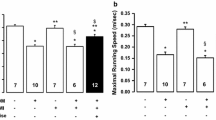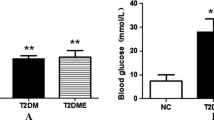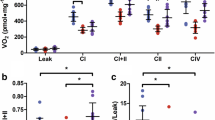Abstract
Diastolic dysfunction is a common complication that occurs early in diabetes mellitus. Titin and collagen are two important regulators of myocardial passive tension, which contributes to diabetic myocardial diastolic dysfunction. Exercise therapy significantly improves the impaired diabetic cardiac function, but its benefits appear to depend on the type of exercise used. We investigated the effect of aerobic and resistance exercise on cardiac diastolic function in diabetic rats induced by high-fat diet combined with low-dose streptozotocin injection. Interestingly, although resistance training had a more pronounced effect on blood glucose control than did aerobic training in type 2 diabetic rats, improvements in cardiac diastolic parameters benefited more from aerobic training. Moreover, aerobic exercise did significantly increase the expression levels of titin and decrease collagen I, TGFβ1 expression level. In summary, out data suggest that aerobic exercise may improve diabetic cardiac function through changes in titin-dependent myocardial stiffness rather than collagen-dependent interstitial fibrosis.





Similar content being viewed by others
References
Zile, M. R., Baicu, C. F., Ikonomidis, J. S., Stroud, R. E., Nietert, P. J., Bradshaw, A. D., Slater, R., Palmer, B. M., Van Buren, P., Meyer, M., Redfield, M. M., Bull, D. A., Granzier, H. L., & LeWinter, M. M. (2015). Myocardial stiffness in patients with heart failure and a preserved ejection fraction: contributions of collagen and titin. Circulation., 131, 1247–1259. https://doi.org/10.1161/CIRCULATIONAHA.114.013215.
LeWinter, M. M., & Granzier, H. L. (2014). Cardiac titin and heart disease. Journal of Cardiovascular Pharmacology, 63, 207–212. https://doi.org/10.1097/FJC.0000000000000007.
Ricard-Blum, S. (2016). The collagen family. Cold Spring Harbor Perspectives in Biology, 3, a004978. https://doi.org/10.1101/cshperspect.a004978.
Franssen, C., & González Miqueo, A. (2016). The role of titin and extracellular matrix remodelling in heart failure with preserved ejection fraction. Netherlands Heart Journal, 24, 259–267. https://doi.org/10.1007/s12471-016-0812-z.
Granzier, H. L., & Irving, T. C. (1995). Passive tension in cardiac muscle: contribution of collagen, titin, microtubules, and intermediate filaments. Biophysical Journal, 68, 1027–1044. https://doi.org/10.1016/S0006-3495(95)80278-X.
Goyal, B., & Mehta, A. (2013). Diabetic cardiomyopathy: pathophysiological mechanisms and cardiac dysfuntion. Human & Experimental Toxicology, 32, 571–590. https://doi.org/10.1177/0960327112450885.
Hölscher, M., Bode, C., & Bugger, H. (2016). Diabetic cardiomyopathy: does the type of diabetes matter? International Journal of Molecular Sciences, 17, 2136. https://doi.org/10.3390/ijms17122136.
Schannwell, C. M., Schneppenheim, M., Perings, S., Plehn, G., & Strauer, B. E. (2002). Left ventricular diastolic dysfunction as an early manifestation of diabetic cardiomyopathy. Cardiology., 98, 33–39. https://doi.org/10.1159/000064682.
Yilmaz, S., Canpolat, U., Aydogdu, S., & Abboud, H. E. (2015). Diabetic cardiomyopathy; summary of 41 years. Korean Circulation Journal, 45, 266–272. https://doi.org/10.4070/kcj.2015.45.4.266.
Brunvand, L., Fugelseth, D., Stensaeth, K. H., Dahl-Jørgensen, K., & Margeirsdottir, H. D. (2016). Early reduced myocardial diastolic function in children and adolescents with type 1 diabetes mellitus a population-based study. BMC Cardiovascular Disorders, 16, 103. https://doi.org/10.1186/s12872-016-0288-1.
Hamdani, N., Franssen, C., Lourenço, A., Falcão-Pires, I., Fontoura, D., Leite, S., Plettig, L., López, B., Ottenheijm, C. A., Becher, P., González, A., Tschöpe, C., Díez, J., Linke, W., Leite Moreira, A., & Paulus, W. (2013). Myocardial titin hypophosphorylation importantly contributes to heart failure with preserved ejection fraction in a rat metabolic risk model. Circulation. Heart Failure, 6, 1239–1249. https://doi.org/10.1161/CIRCULATIONAHA.114.013215.
Krüger, M., Babicz, K., von Frieling-Salewsky, M., & Linke, W. A. (2010). Insulin signaling regulates cardiac titin properties in heart development and diabetic cardiomyopathy. Journal of Molecular and Cellular Cardiology, 48, 910–916. https://doi.org/10.1016/j.yjmcc.2010.02.012.
Tokudome, T., Horio, T., Yoshihara, F., Suga, S.-i., Kawano, Y., Kohno, M., & Kangawa, K. (2004). Direct effects of high glucose and insulin on protein synthesis in cultured cardiac myocytes and DNA and collagen synthesis in cardiac fibroblasts. Metabolism., 53, 710–715. https://doi.org/10.1016/j.metabol.2004.01.006.
Souders, C. A., Bowers, S. L. K., & Baudino, T. A. (2009). Cardiac fibroblast: the renaissance cell. Circulation Research, 105, 1164–1176. https://doi.org/10.1161/CIRCRESAHA.109.209809.
Bacchi, E., Negri, C., Zanolin, M. E., Milanese, C., Faccioli, N., Trombetta, M., Zoppini, G., Cevese, A., Bonadonna, R. C., Schena, F., Bonora, E., Lanza, M., & Moghetti, P. (2012). Metabolic effects of aerobic training and resistance training in type 2 diabetic subjects: a randomized controlled trial (the RAED2 study). Diabetes Care, 35, 676–682. https://doi.org/10.2337/dc11-1655.
Hidalgo, C., Saripalli, C., & Granzier, H. L. (2014). Effect of exercise training on post-translational and post-transcriptional regulation of titin stiffness in striated muscle of wild type and IG KO mice. Archives of Biochemistry and Biophysics, 552–553, 100–107. https://doi.org/10.2337/dc11-1655.
Hayashi, T., Wojtaszewski, F. P., & Goodyear, L. J. (1997). Execise regulation of glucose transport in skeletal muscle. American Journal of Physiology. Endocrinology and Metabolism, 273, E1039–E1051. https://doi.org/10.1152/ajpendo.1997.273.6.E1039.
Ribeiro, C., Cambri, L. T., Dalia, R. A., de Araújo, M. B., Botezelli, J. D., Sponton, A. C. S., & de Mello, M. A. R. (2012). Effects of physical training with different intensities of effort on lipid metabolism in rats submitted to the neonatal application of alloxan. Lipids in Health and Disease, 11, 138. https://doi.org/10.1186/1476-511X-11-138.
Sylow, L., Kleinert, M., Richter, E., & Jensen, T. (2017). Exercise-stimulated glucose uptake — regulation and implications for glycaemic control. Nature Reviews. Endocrinology, 13, 133–148. https://doi.org/10.1038/nrendo.2016.162.
Cauza, E., Hanusch-Enserer, U., Strasser, B., Ludvik, B., Metz-Schimmerl, S., Pacini, G., Wagner, O., Georg, P., Prager, R., Kostner, K., Dunky, A., & Haber, P. (2005). The relative benefits of endurance and strength training on the metabolic factors and muscle function of people with type 2 diabetes mellitus. Archives of Physical Medicine and Rehabilitation, 86, 1527–1533. https://doi.org/10.1016/j.apmr.2005.01.007.
Ishiguro, H., Kodama, S., Horikawa, C., Fujihara, K., Sugawara Hirose, A., Hirasawa, R., Yachi, Y., Ohara, N., Shimano, H., Hanyu, O., & Sone, H. (2015). Search of the ideal resistance training program to improve glycemic control and its indication for patients with type 2 diabetes mellitus: a systematic review and meta-analysis. Sports Medicine, 46, 67–77. https://doi.org/10.1007/s40279-015-0379-7.
Ivy, J. (1997). Role of exercise training in the prevention and treatment of insulin resistance and non-insulin-dependent diabetes mellitus. Sports Medicine, 24, 321–336. https://doi.org/10.2165/00007256-199724050-00004.
Weeks, D. L. (2007). Exercise interventions for diabetes control: do we really know that strength training is better than endurance training? Archives of Physical Medicine and Rehabilitation, 88, 397. https://doi.org/10.1016/j.apmr.2007.01.008.
Stalin, A., Irudayaraj, S. S., Gandhi, G. R., Balakrishna, K., Ignacimuthu, S., & Al-Dhabi, N. A. (2016). Hypoglycemic activity of 6-bromoembelin and vilangin in high-fat diet fed-streptozotocin-induced type 2 diabetic rats and molecular docking studies. Life Sciences, 153, 100–117. https://doi.org/10.1016/j.lfs.2016.04.016.
Epp, R. A., Susser, S. E., Morissette, M. P., Kehler, D. S., Jassal, D. S., & Duhamel, T. A. (2012). Exercise training prevents the development of cardiac dysfunction in the low-dose streptozotocin diabetic rats fed a high-fat diet. Canadian Journal of Physiology and Pharmacology, 91, 80–89. https://doi.org/10.1139/cjpp-2012-0294.
Gu, H., Xia, X., Chen, Z., Liang, H., Yan, J., Xu, F., & Weng, J. (2014). Insulin therapy improves islet functions by restoring pancreatic vasculature in high-fat diet-fed streptozotocin-diabetic rats. Journal of Diabetes, 6, 228–236. https://doi.org/10.1111/1753-0407.12095.
Bedford, T. G., Tipton, C. M., Wilson, N. C., Oppliger, R. A., & Gisolfi, C. V. (1979). Maximum oxygen consumption of rats and its changes with various experimental procedures. Journal of Applied Physiology: Respiratory, Environmental and Exercise Physiology, 47, 1278–1283. https://doi.org/10.1152/jappl.1979.47.6.1278.
Hornberger, T. A., Jr., & Farrar, R. P. (2004). Physiological hypertrophy of the FHL muscle following 8 weeks of progressive resistance exercise in the rat. Canadian Journal of Applied Physiology, 29, 16–31. https://doi.org/10.1139/h04-002.
Fang, Z. Y., Prins, J. B., & Marwick, T. H. (2004). Diabetic cardiomyopathy: evidence, mechanisms, and therapeutic implications. Endocrine Reviews, 25, 543–567. https://doi.org/10.1210/er.2003-0012.
Jia, G., Whaley-Connell, A., & Sowers, J. R. (2018). Diabetic cardiomyopathy: a hyperglycaemia- and insulin-resistance-induced heart disease. Diabetologia., 61, 21–28. https://doi.org/10.1007/s00125-017-4390-4.
Astorri, E., Fiorina, P., Astorri, A., Contini, G. A., Albertini, D., Magnati, G., & Lanfredini, M. (1997). Isolated and preclinical impairment of left ventricular filling in insulin-dependent and non-insulin-dependent diabetic patients. Clinical Cardiology, 20, 536–540. https://doi.org/10.1002/clc.4960200606.
Aziz, F., Tk, L.-A., Enweluzo, C., Dutta, S., & Zaeem, M. (2013). Diastolic heart failure: a concise review. Journal of Clinical Medical Research, 5, 327–334. https://doi.org/10.4021/jocmr1532w.
Boyer, J. K., Thanigaraj, S., Schechtman, K. B., & Pérez, J. E. (2004). Prevalence of ventricular diastolic dysfunction in asymptomatic, normotensive patients with diabetes mellitus. The American Journal of Cardiology, 93, 870–875. https://doi.org/10.1016/j.amjcard.2003.12.026.
Böhm, A., Weigert, C., Staiger, H., & Häring, H.-U. (2016). Exercise and diabetes: relevance and causes for response variability. Endocrine., 51, 390–401. https://doi.org/10.1007/s12020-015-0792-6.
Rees, J. L., Johnson, S. T., & Boulé, N. (2017). Aquatic exercise for adults with type 2 diabetes: a meta-analysis. Acta Diabetologica, 54, 895–904. https://doi.org/10.1007/s00592-017-1023-9.
Ried-Larsen, M., MacDonald, C. S., Johansen, M. Y., Hansen, K., Christensen, R., Almdal, T. P., Pedersen, B. K., & Karstoft, K. (2018). Why prescribe exercise as therapy in type 2 diabetes? We have a pill for that! Diabetes/Metabolism Research and Reviews, 34, e2999. https://doi.org/10.1002/dmrr.2999.
Solene Le Douairon, L., Francoise Rannou, B., & Tom, B. (2014). Physical activity and diabetic cardiomyopathy: myocardial adaptation depending on exercise load. Current Diabetes Reviews, 10, 371–390. https://doi.org/10.2174/1573399811666141229151421.
Brown, B., Somauroo, J., Green, D., Wilson, M., Drezner, J., George, K., & Oxborough, D. (2017). The complex phenotype of the athlete’s heart: implications for preparticipation screening. Exercise and Sport Sciences Reviews, 45, 96–104. https://doi.org/10.1249/JES.0000000000000102.
Morganroth, J., Maron, B. J., Henry, W. L., & Epstein, S. E. (1975). Comparative left ventricular dimensions in trained athletes. Annals of Internal Medicine, 82, 521–524. https://doi.org/10.7326/0003-4819-82-4-521.
Eliane Hopf, A., Andresen, C., Kötter, S., Isic, M., Ulrich, K., Salcan, S., Bongardt, S., Roell, W., Drove, F., Scheerer, N., Vandekerckhove, L., Keulenaer, G., Hamdani, N., Linke, W., & Krüger, M. (2018). Diabetes-induced cardiomyocyte passive stiffening is caused by impaired insulin-dependent titin modification and can be modulated by neuregulin-1. Circulation Research, 123, 342–355. https://doi.org/10.1161/CIRCRESAHA.117.312166}.
Røe, Å. T., Aronsen, J. M., Skårdal, K., Hamdani, N., Linke, W. A., Danielsen, H. E., Sejersted, O. M., Sjaastad, I., & Louch, W. E. (2017). Increased passive stiffness promotes diastolic dysfunction despite improved Ca2+ handling during left ventricular concentric hypertrophy. Cardiovascular Research, 113, 1161–1172. https://doi.org/10.1093/cvr/cvx087.
Krüger, M., Kötter, S., Grützner, A., Lang, P., Andresen, C., Redfield, M. M., Butt, E., dos Remedios, C. G., & Linke, W. A. (2009). Protein kinase G modulates human myocardial passive stiffness by phosphorylation of the titin springs. Circulation Research, 104, 87–94. https://doi.org/10.1016/j.bpj.2008.12.2003.
Nagueh, S. F., Shah, G., Wu, Y., Torre-Amione, G., King, N. M. P., Lahmers, S., Witt, C. C., Becker, K., Labeit, S., & Granzier, H. L. (2004). Altered titin expression, myocardial stiffness, and left ventricular function in patients with dilated cardiomyopathy. Circulation., 110, 155–162. https://doi.org/10.1161/01.CIR.0000135591.37759.AF.
Warren, C. M., Jordan, M. C., Roos, K. P., Krzesinski, P. R., & Greaser, M. L. (2003). Titin isoform expression in normal and hypertensive myocardium. Cardiovascular Research, 59, 86–94. https://doi.org/10.1016/S0008-6363(03)00328-6.
Wu, Y., Bell, S. P., Trombitas, K., Witt, C. C., Labeit, S., LeWinter, M. M., & Granzier, H. (2002). Changes in titin isoform expression in pacing-induced cardiac failure give rise to increased passive muscle stiffness. Circulation., 106, 1384–1389. https://doi.org/10.1161/01.CIR.0000029804.61510.02.
Yamasaki, R., Wu, Y., McNabb, M., Greaser, M., Labeit, S., & Granzier, H. (2002). Protein kinase A phosphorylates titin’s cardiac-specific N2B domain and reduces passive tension in rat cardiac myocytes. Circulation Research, 90, 1181–1188. https://doi.org/10.1161/01.RES.0000021115.24712.99.
Neagoe, C., Kulke, M., del Monte, F., Gwathmey, J. K., de Tombe, P. P., Hajjar, R. J., & Linke, W. A. (2002). Titin isoform switch in ischemic human heart disease. Circulation., 106, 1333–1341. https://doi.org/10.1161/01.CIR.0000029803.93022.93.
Hsu, K. L., Tsai, C. H., Chiang, F.-T., Lo, H., Tseng, C. D., Wang, S. M., Chen, C. F., & Tseng, Y. Z. (1997). Myocardial mechanics and titin in experimental insulin-resistant rats. Japanese Heart Journal, 38, 717–728. https://doi.org/10.1536/ihj.38.717.
Lehti, M., Silvennoinen, M., Kivelä, R., Kainulainen, H., & Komulainen, J. (2006). Effects of streptozotocin-induced diabetes and physical training on gene expression of extracellular matrix proteins in mouse skeletal muscle. American Journal of Physiology. Endocrinology and Metabolism, 290, E900–E9E7. https://doi.org/10.1152/ajpendo.00444.2005.
Shah, M. S., & Brownlee, M. (2016). Molecular and cellular mechanisms of cardiovascular disorders in diabetes. Circulation Research, 118, 1808–1829. https://doi.org/10.1161/CIRCRESAHA.116.306923.
Teran-Garcia, M., Rankinen, T., Koza, R. A., Rao, D. C., & Bouchard, C. (2005). Endurance training-induced changes in insulin sensitivity and gene expression. American Journal of Physiology. Endocrinology and Metabolism, 288, 1168–1178. https://doi.org/10.1152/ajpendo.00467.2004.
Mcguigan, M. R., Sharman, M. J., Newton, R. U., Davie, A. J., Murphy, A. J., & Mcbride, J. M. (2003). Effect of explosive resistance training on titin and myosin heavy chain isoforms in trained subjects. Journal of Strength and Conditioning Research, 17, 645–651. https://doi.org/10.1519/00124278-200311000-00004.
Kwak, H. B. (2013). Aging, exercise, and extracellular matrix in the heart. Journal of Exercise Rehabilitation., 9, 338–347. https://doi.org/10.12965/jer.130049.
Russo, I., & Frangogiannis, N. G. (2016). Diabetes-associated cardiac fibrosis: cellular effectors, molecular mechanisms and therapeutic opportunities. Journal of Molecular and Cellular Cardiology, 90, 84–93. https://doi.org/10.1016/j.yjmcc.2015.12.011.
Calligaris, S. D., Lecanda, M., Solis, F., Ezquer, M., Gutiérrez, J., Brandan, E., Leiva, A., Sobrevia, L., & Conget, P. (2013). Mice long-term high-fat diet feeding recapitulates human cardiovascular alterations: an animal model to study the early phases of diabetic cardiomyopathy. PLoS One, 8, e60931. https://doi.org/10.1371/journal.pone.0060931.
Namba, T., Tsutsui, H., Tagawa, H., Takahashi, M., & Takeshita, A. (1997). Regulation of fibrillar collagen gene expression and protein accumulation in volume-overloaded cardiac hypertrophy. Circulation, 95, 2448–2454. https://doi.org/10.1161/01.CIR.95.10.2448.
Norambuena-Soto, I., Núñez-Soto, C., Sanhueza Olivares, F., Cancino-Arenas, N., Mondaca-Ruff, D., Vivar, R., Diaz-Araya, G., Mellado, R., & Chiong, M. (2017). Transforming growth factor-beta and Forkhead box O transcription factors as cardiac fibroblast regulators. Bioscience Trends, 11, 154–162. https://doi.org/10.5582/bst.2017.01017.
Serralheiro, P., Cairrao, E., Maia, C. J., Joao, M., Almeida, C. M. C., & Verde, I. (2017). Effect of TGF-beta1 on MMP/TIMP and TGF-beta1 receptors in great saphenous veins and its significance on chronic venous insufficiency. Phlebology., 32, 334–341. https://doi.org/10.1177/0268355516655067.
Xu, H., He, Y., Feng, J. Q., Shu, R., Liu, Z., Li, J., Wang, Y., Xu, Y., Zeng, H., Xu, X., Xiang, Z., Xue, C., Bai, D., & Han, X. (2017). Wnt3α and transforming growth factor-β induce myofibroblast differentiation from periodontal ligament cells via different pathways. Experimental Cell Research, 353, 55–62. https://doi.org/10.1016/j.yexcr.2016.12.026.
Funding
This study was funded by Sichuan Science and Technology Program [grant numbers 2018JY0499] and Sports Medicine key Laboratory of General Administration of Sport of China [grant numbers 2018-A008].
Author information
Authors and Affiliations
Corresponding author
Ethics declarations
Conflict of Interest
The authors declare that they have no conflict of interest.
Ethical Approval
This article does not contain any studies with human participants performed by any of the authors. All applicable international, national, and institutional guidelines for the care and use of animals were followed.
Additional information
Associate Editor Enrique Lara-Pezzi oversaw the review of this article
Publisher’s Note
Springer Nature remains neutral with regard to jurisdictional claims in published maps and institutional affiliations.
Rights and permissions
About this article
Cite this article
Li, S., Liang, M., Gao, D. et al. Changes in Titin and Collagen Modulate Effects of Aerobic and Resistance Exercise on Diabetic Cardiac Function. J. of Cardiovasc. Trans. Res. 12, 404–414 (2019). https://doi.org/10.1007/s12265-019-09875-4
Received:
Accepted:
Published:
Issue Date:
DOI: https://doi.org/10.1007/s12265-019-09875-4




